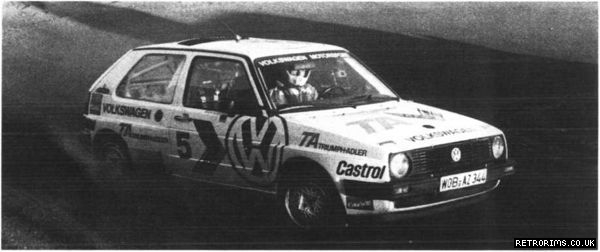That same year, 1983, Kalle Grundel took the Group A Golf GTI rally car to victory in the German Rally Championship and, behind the scenes, VW Motorsport were starting work on its replacement as the new Golf was phased in. Up to that point, Group 1 and Group lb GTIs had 148 or 150bhp for the track and the rally cars, in Group A, anything from 170bhp to 200bhp depending on spec. The Bimotor Scirocco was originally devised as a Group B rally weapon, but it w as not until 1985 that the green light was given to incorporate the lessons learnt from this car into an official rally machine. The Twin Golf was not going to enter the fray of international rallying though; its objective was an attempt at the Pikes Peak hill climb record with successful GTI driver Jochi Kleint at the wheel.



Pikes Peak in the Rocky Mountains in Colorado is over 13,000ft high. The view from the startline, over 8,500ft up, is breathtaking and of course the altitude extracts a heavy toll on naturally aspirated engines. The winding, loose surface road up the mountain is 9.4 miles long and has 156 turns.
VW’s challenge to nature had a pair of l,807cc Oettinger engines of 195bhp apiece to power it and, running an 11.0:1 compression ratio, they supplemented the combined 390bhp at 7,500rpm with 3381b/ft of torque at 5,800rpm. Performance was not dissimilar to the Bimotor Sciroccos with a 0-60mph time of 4.3 seconds and a top speed of 162mph depending on final drive. It was quickly established that the altitude was doing the car’s engines no favours and for a really serious assault on the Peak in 1986, a change of tactics was called for. To keep the car in its engine capacity class, and use turbocharging, VW had to resort to the use of much smaller engines. Their choice was the 1,300cc Polo engine, and these small power units were modified to take a KKK turbocharger each, with intercooling. Bosch K-Jetronic fuel injection was grafted onto the engines and boost pressure was variable between 1.4 and 2.0 bar. At peak boost, these 8.5:1 compression engines kicked out 250bhp each giving a sum total of 500bhp at 7,000rpm and 3841b/ft of torque at 6,000rpm. Weighing just 2,3101b, 1001b less than a Corrado and about 2501b heavier than a Golf GTI, the 1986 Twin Golf was good for a 3.4 second burst to 60mph and a top speed of 193mph!
That car was still essentially a Golf beneath the sheetmetal work, though, and for the 1987 attempt on the Peak, VW fielded what amounted to a silhouette racer. The centre section of the car was a monocoque cell constructed largely from aluminium in the best racing-car tradition. From this were hung the front and rear tubular space frames to which the engines and suspension components were attached. Although, to onlookers, the front and rear detachable engine covers were perfect replicas of a production Golfs, even with standard looking wheelarches, these were just glassfibre components held in place by quick release fixtures. The car weighed just 2,2441b and had 652bhp to propel it. That is a power-to-weight ratio of 3.431b bhp! Unlike all the previous cars, this one had the engines mounted in-line. Those engines were a pair of 1.8-litre 16-valve Golf engines prepared by Kaimann Racing to full competition spec. An intercooled KKK turbocharger boosted each one to 1.3 bar at full throttle and, with the 8.5:1 compression ratio, output was 652bhp at 6,800rpm and 4281b/ft at 6,400rpm. Two huge fans extracted air through the rearmounted radiators giving the rear of the car the appearance of a James Bond movie car that looked equally capable of aquatic duties. 0-60mph took 4.1 seconds and the car was geared for just 114mph through Formula 2 Hewland gearboxes and running on 225/50VR16 tyres.

The three Pikes Peak Golfs never won their events but they finished in the top ten in the three years they competed. They provided valuable experience with regard to the synchronization of two engines in one chassis and what could be achieved with four-wheel drive. These full-house competition Twin Golfs were also the ultimate expression of an idea that was born over a few drinks in a bar seven years earlier.
©Ian Kuah. This article was published with explicit permission from author Ian Kuah



